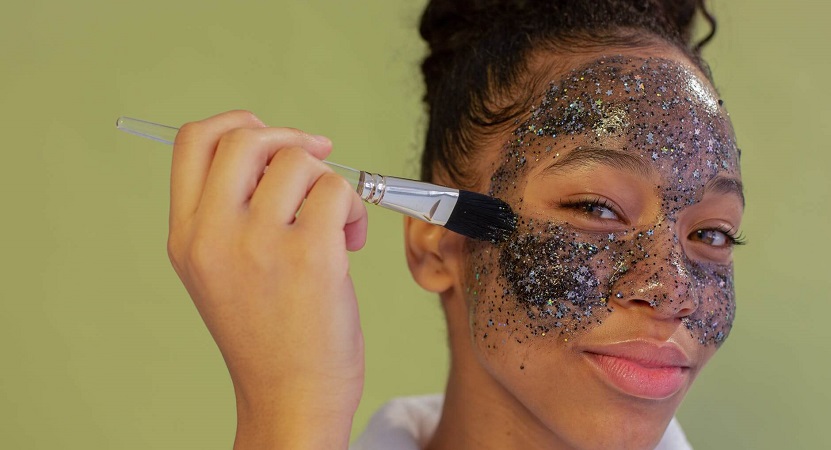Say what you like about chemical peels, but it’s impossible to argue that these medical-grade procedures aren’t totally revolutionary when it comes to human skin. Chemical peels are now widely accessible and can even be performed from the comfort of your humble abode — intrigued?
In this article we discuss the following:
- Do Chemical Peels Work?
- Chemical Peel Strength Chart
- Benefits of Chemical Peel
- At Home Chemical Peel Reviews
- What is the Best Chemical Peel?
- How to do a Chemical Peel at Home
- Chemical Peel at Home: Where to Buy
Do Chemical Peels Work?
At Home Chemical Peel vs. Professional
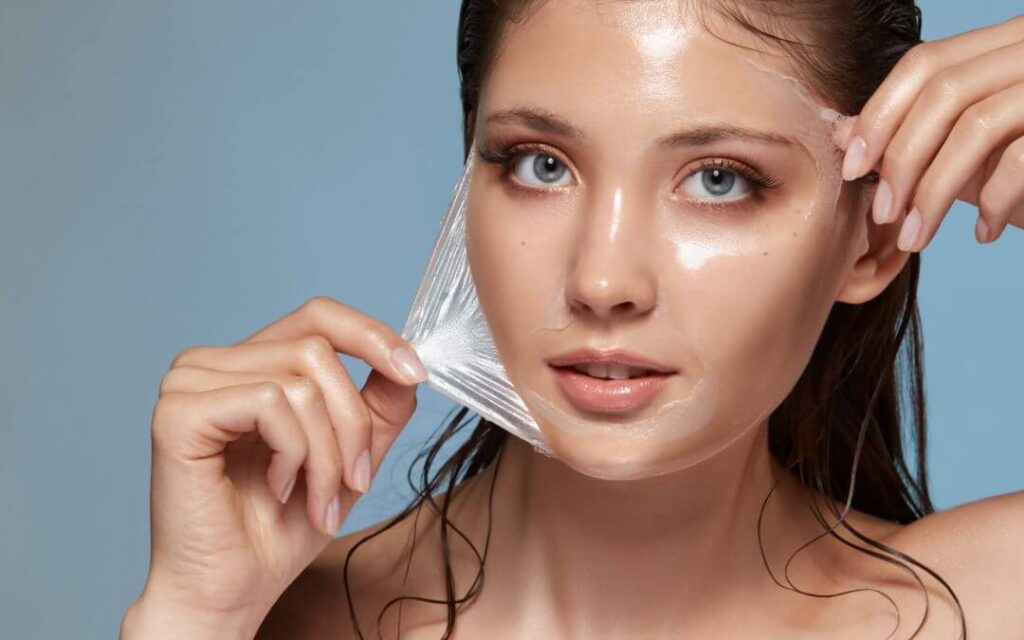
Whether you’re receiving a chemical peel from a professional, or performing one on yourself at home, the intention of these procedures is always the betterment of the skin’s condition using acid compounds. Dr. James Beckman, Board Certified Plastic and Reconstructive Surgeon and founder/CEO of Theraderm Clinical Skin Care, explains that “Chemical peels work to restore skin damaged by sunlight and life experiences. Nearly all peel formulations utilize one or more acids to react with the skin.”
Medical grade chemical peel brands are now more freely available to the public for at home use, but Dr. Beckman maintains that certain peels are best left to the experts. “Medium and deeper peels are best done by medical professionals as complications can occur such as scarring or hyper-pigmentation formation.”
Are Chemical Peels Safe for Sensitive Skin?
In short, the answer to this question is very much dependent on the condition of the skin at the time of the peel, and not so much on the sensitivity of the skin in general. People with sensitive skin can usually handle milder-intensity peels just fine, however if there is an active outbreak of acne, rashes or even flaking at the time of the peel, then it may be wiser to wait for these conditions to subside a little first.
As with anything acidic and chemical, there is always a risk. Some people can trigger dark spots after chemical peel. Dr. Beckman explains this in more detail, stating that “It is important to use lower concentrations of peel acids on darker skin types to avoid a reactive hyperpigmentation problem to the skin. Light skin types tolerate deeper peeling than darker skin types.” — Good to know!
If you feel you have extremely sensitive skin that is generally not tolerable toward acids, then looking into a natural chemical peel could be a great alternative!
How Often Should you do a Chemical Peel at Home?
First rule of thumb: you never want to be doing repetitive cheap chemical peels from unreliable brands. This is a one way ticket to lasting skin damage that may cost the equivalent of a mortgage to correct.
Always opt for quality, reputable products that come with a degree of accountability — even if it costs a few extra pennies to purchase!
Mild at-home chemical peels can be performed weekly or biweekly, depending on the general sensitivity of the skin in question. More than this is considered overkill, as a key component to any skin treatment is healing and regenerative time in between treatments. Overpeeling can severely disrupt microbiome colonies and leave the skin raw.
Do Chemical Peels Work?
Yes, they very much do. Due to the highly acidic nature of these formulas, chemical peels can almost never “do nothing” to the skin upon which they are adhered. Even if you don’t get the profound changes you were expecting, very few people walk away without any effect at all on the skin. These are strong treatments, and results are to be expected (when used properly and responsibly, of course!).
It also helps to know that you don’t have to be left totally in the dark and alone in your application process. Dr. Christine Bishara recently founded an at-home chemical peel procedure called Virtual Peel, whereby the patient has virtual support throughout the process. You’ll be guided step-by-step through the entire process, while never having to leave your home to reap the benefits.
“A thorough screening process is performed to make sure each patient is the right candidate and to minimize risk of adverse effects. Then, the peel is sent and a virtual application is scheduled. I currently use the VI Peels because they provide maximum results with little pain or risk of complications. I have had great results!” exclaims Dr. Bishara, proudly.
Chemical Peel Strength Chart
If at-home chemical peeling is something you’re interested in getting into long-term, then it’s important that you start to familiarize yourself with the universal chemical peel comparison chart.
These charts are basic breakdowns of chemical strengths in relation to different skin and sensitivity types. They give one a point of reference for what to expect from different chemical peels, depending on what kind of skin they have.
Yes, there are some chemical peels that are more suited to certain skin-types compared to others. And yes, you can put your skin at risk if you don’t double check strength suitability.
Here is an example of a strength chart that is well-detailed and researched:
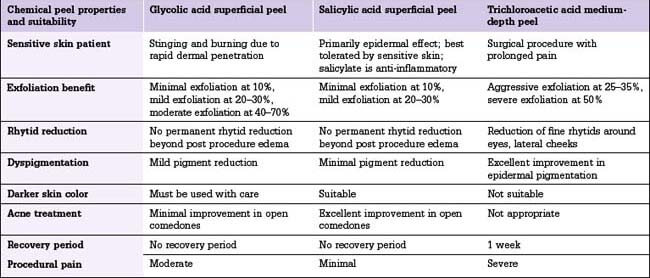
Levels of Chemical Peels
When shopping around, you might see something labeled “level 2 chemical peel” — but what does all this actually mean?
According to Dr. Beckman, “It is useful to classify peels as superficial, medium, and deeper depth peel action”. Superficial peels are most common for at-home use. “Superficial peels act primarily only to the depth of the epidermis. These peels are designed to injure yet not exfoliate the epidermal cells. Benefits to use of superficial peels include smoother, softer skin and elimination of fine lines and wrinkles.” says Dr. B.
Glycolic acid chemical peels are common, and are considered to be safe yet potent at-home treatments, when used with care. “Glycolic and Lactic acids are very short molecules so have a quick action. Being alpha-hydroxy acids, their action must be neutralized by rapidly washing off the skin with water and or sodium bicarbonate to stop the chemical action and prevent burning the skin.” cautions Dr. Beckman.
As mentioned earlier, it is important to use lower levels of chemical concentrations on darker skin types to avoid reactions of hyperpigmentation. “Light skin types tolerate deeper peeling than darker skin types. Using a lower concentration chemical to peel to a lesser depth than might be needed and then repeating the peel later is a good idea if there is any doubt of safety.”
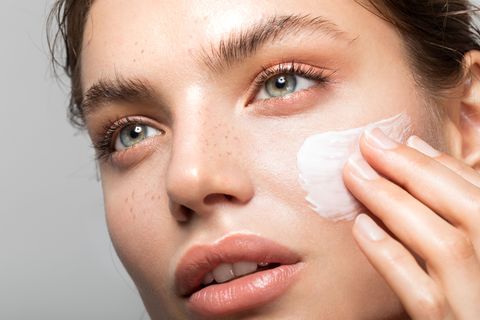
Benefits of Chemical Peel
Chemical Peel for Acne Scars
Dr. Beckman adds that, as a standard, the following benefits can be expected from using at-home chemical peels: “Restoration is due to healing and new, younger cell formation that follows the skin injury caused by the peel. The deeper the injury, the more cell types and different composition of skin layers such as collagen are restored. Any exfoliation causes some increased collagen deposition within skin. This has an effect to “tighten” loose skin.”
So what about using this process for the purpose of healing acne scars? Chemical peels are widely regarded as one of the best ways of improving the appearance of acne scarring. It’s important to note that scars that are older than 10 years of age can never fully be healed, however peels can help significantly with their depth and visual intensity. Acne scars younger than 10 years of age can be drastically improved, sometimes to the point of total restoration.
Chemical peels target acne scarring by burning away the old layer of damaged skin, allowing new, cellular rejuvenated skin to take its place.
Chemical Peel for Dark Spots
Like acne, dark spots are not a match for quality chemical peels. Again, these peels will simply target the layers of skin where the dark patches take up residence, slowly wearing them away so that brand new skin may take its place.
The best chemical peels for the treatment of dark spots are any that contain alpha hydroxy acids, beta hydroxy acids, or trichloroacetic acid.
Chemical Peel for Wrinkles
Individuals with mild to moderate wrinkles and sagging can receive great benefit from performing at-home chemical peels on a regular basis. Chemical peels promote collage deposits back into the sagging skin, which leaves wrinkles naturally fuller and more plump over time.
Compared to microneedling and other minimally invasive skin procedures for wrinkles, chemical peels are regarded as the more effective choice due to their different potencies and ability to erase fine lines in a short period of time.
Chemical Peel for Hands
The hands age faster than the face, if you can believe it! Our hands are prone to excessive environmental exposure that does sure, fast damage to the collagen makeup of our cells. The result is usually sagging skin, age spots and generally poor texture, particularly around the knuckles.
The good news is that if chemical peels are safe for face, they are generally also safe for hands! The thin skin that makes up the hand surface can be replenished, rejuvenated and restored the same way facial skin can.
Chemical Peel for Legs and Arms
While we’re at it, did you know that you can chemical peel the skin your legs and even your arms? These parts of the body also encounter damage due to environmental exposure, though usually less thanks to the cover that clothing provides. Those who spend a lot of time in the sun may have more damaged leg/arm skin that can benefit greatly from chemical peels.
Chemical peels on legs usually work to improve spots (sun damage/freckles), keratosis skin, and sagging around the knees (or elbows in the case of arms).
Chemical Peel for Dry Skin
Surprisingly, chemical peels can be a cure for extremely dry, flaking skin. Superficial peels will eat away the outer layer of skin (the epidermis), leaving the softer layer below to steal the show. Most chemical peels are slightly exfoliating, which is great for any kind of skin flaking condition.
Chemical Peel for Brown Skin
Darker skin tones can enjoy all of the benefits of chemical peeling, but they should be careful and considerate when it comes to strength. As we’ve mentioned, darker skin is more prone to reactions of hyperpigmentation after strong chemical peels. For this reason, mild superficial peels are more recommended for optimal benefit.
Deep peels should be used with caution on brown skin, no matter how non-sensitive the individual in question believes their skin to be.
Chemical Peel for Age Spots
In the same way that chemical peels target wrinkles and dryness, they also affect the outer layer of skin where age spots tend to congregate. By treating this skin layer, age spots are able to gradually rejuvenate on a cellular level.
Chemical peels are not a quick fix for this kind of skin impairment, but over time they can produce drastic improvement in appearance
At Home Chemical Peel Reviews
Chemical Peel at Home: Before and After
Chemical peels are treatments that usually show results after first use. For this reason, using before and after testimonials and images from existing patients can be a great way to assess the possibilities of such usage.
For the most part, patient reviews across the Internet have mixed emotions when it comes to their personal experiences. Many praise these treatments, saying that they only wish they had started sooner! Others are less convinced, having seemingly struggled with the self-application aspect or general feelings of overwhelm in handling such an acidic procedure without supervision.
Chemical Peel for Wrinkles: Before and After
Because wrinkles are the most common condition targeted with chemical peels, there is a myriad of reviews and before and after imagery available on the Internet attesting to thousands of personal experiences!
Overall, almost all of the claims seem to be utterly positive, albeit a few who perhaps had higher hopes for some deeper, persistent lines. Those that didn’t see any improvement in their wrinkle appearance do still remark on a general improvement in their overall skin texture and condition.
Here are some before and after images from individuals who used chemical peels for wrinkles:
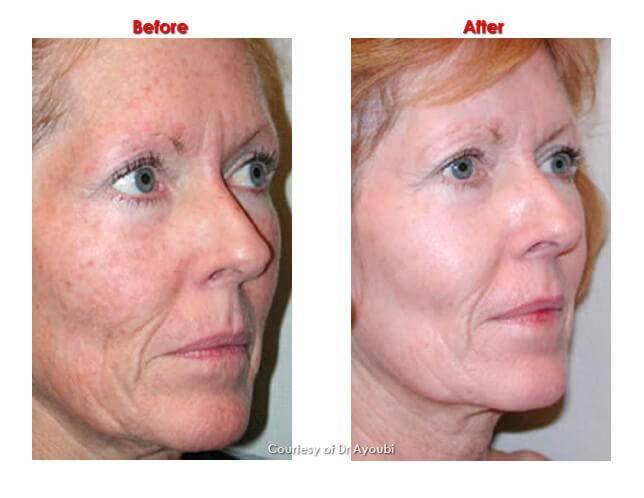
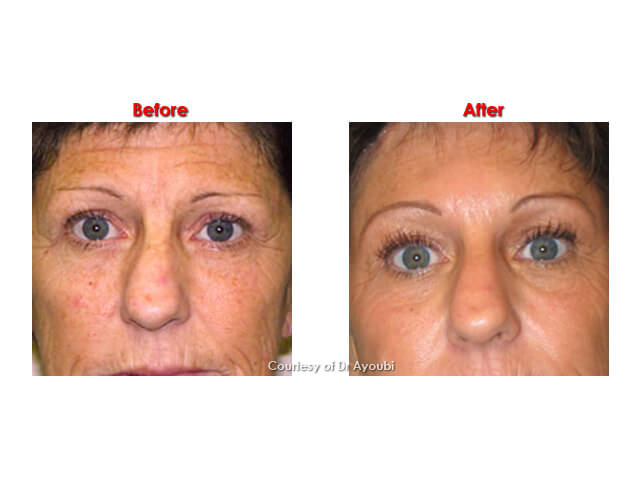
Chemical Peel for Acne Scars: Before and After
If you’re not sold on performing your own chemical peels for acne scars at home, you can easily search for “chemical peel for acne scars near me” instead! But if you’re ready to take the plunge, know that many have walked this path before you, and have left behind a helpful trail of testimonials and document imagery to light the way for others.
Using chemical peels for acne scarring is about as popular as wrinkle treatment is, with an ever growing interest due to the endemic that is acne (harming the skin of adolescents through to adults).
Here are some before and after images for this specific condition:
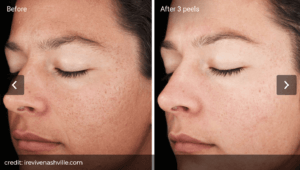
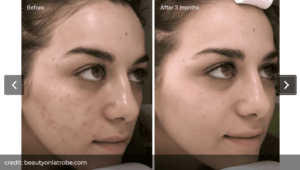
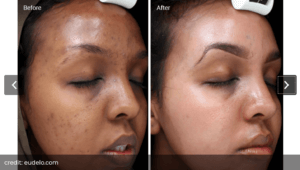
Chemical Peel for Hyperpigmentation: Before and After
Since hyperpigmentation can both be treated by and caused by chemical peels, it’s important to do some research before using this procedure on your own skin. The reviews on this matter are extremely varied, and we’d encourage readers not to be deterred from chemical peels due to the misfortune of another and their negative experience of a peel. People tend to be very vocal when things go wrong and they feel like a product has been unjust, however often fail to mention their own carelessness or lack of research prior to adopting said treatment.
Do your research, talk to a professional if you need to, and make the best decision for your skin and your skin only! Here are some before and after improvement images for hyperpigmentation treated with chemical peels:

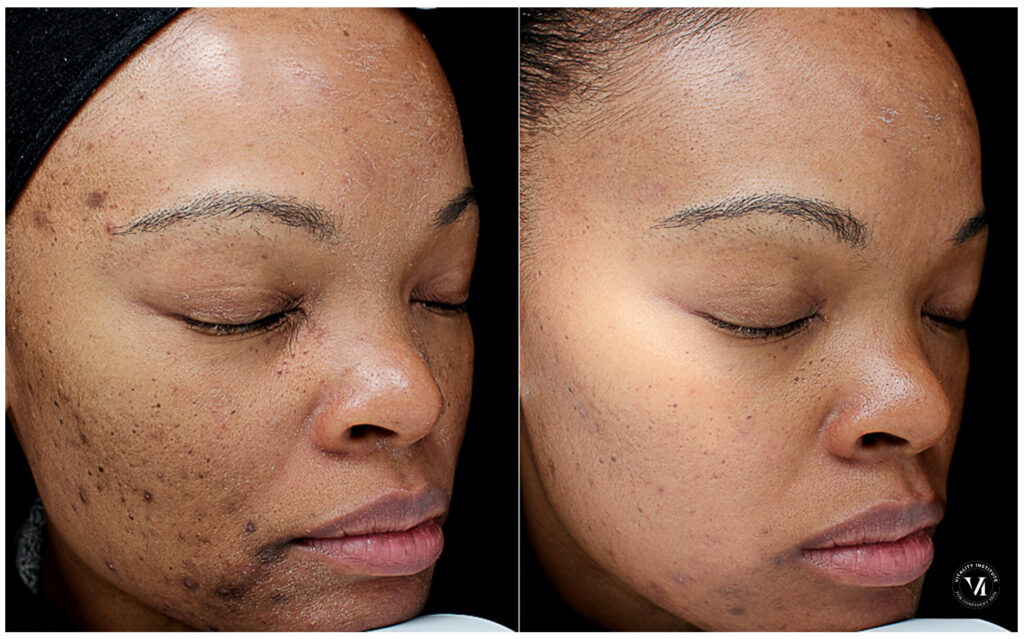
What is the Best Chemical Peel?
Best at Home Chemical Peel for Hyperpigmentation
Perfect Image Lactic 10% Gel Peel
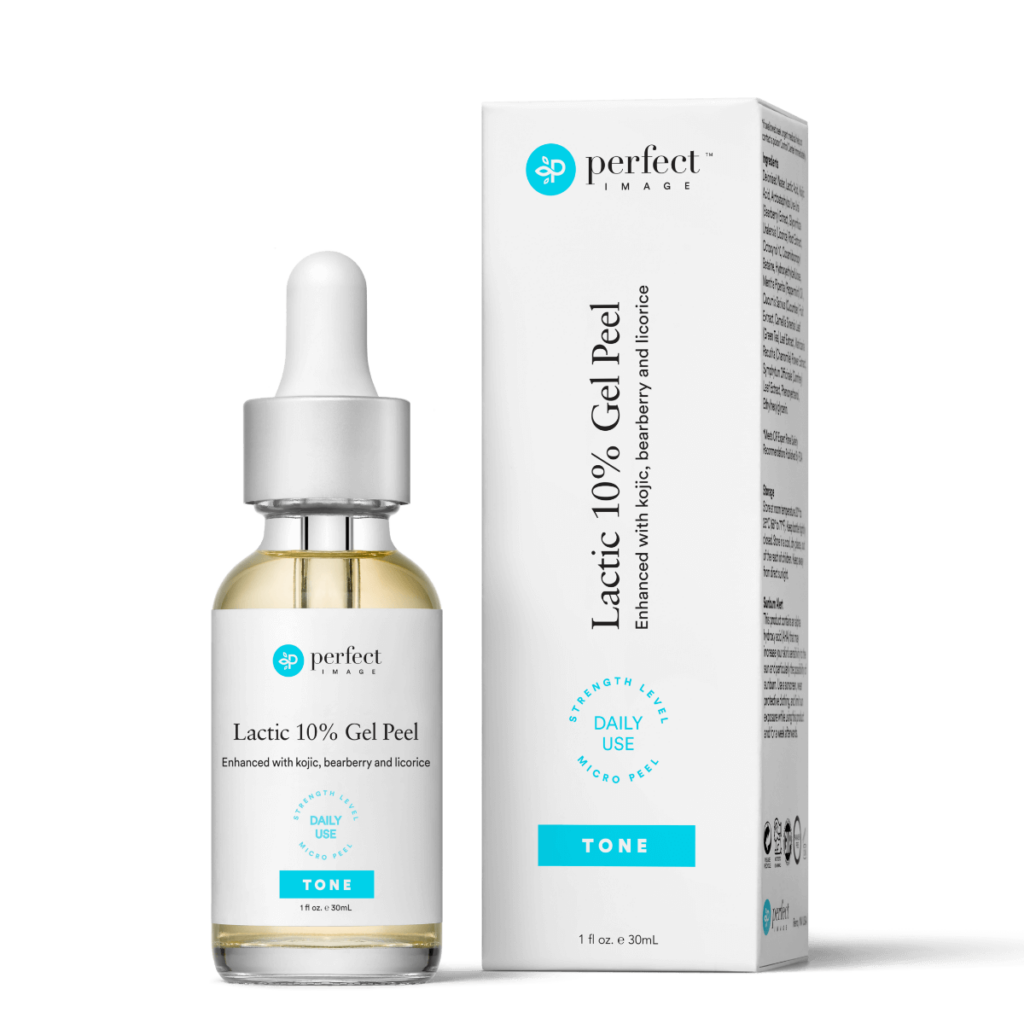
Dark spots and hyperpigmentation will soon be a thing of the past once this gentle peel is incorporated into your weekly skincare routine. The key ingredient is kojic acid, which blocks the tyrosine enzyme in the skin, preventing the overproduction of melanin.
As darker patches fade away, it’s not unlikely that the entire surface of the treated skin will fade too. This product has a way of bringing skin tone back to its original shade, before a lifetime of sun exposure and damage.
To add to the healing properties of the peel, there is fresh cucumber extract within every bottle. Cucumber, as we know, is extremely soothing to burdened skin and can help with the rejuvenation of the treated areas.
Best Chemical Peel for Hyperpigmentation on Black Skin
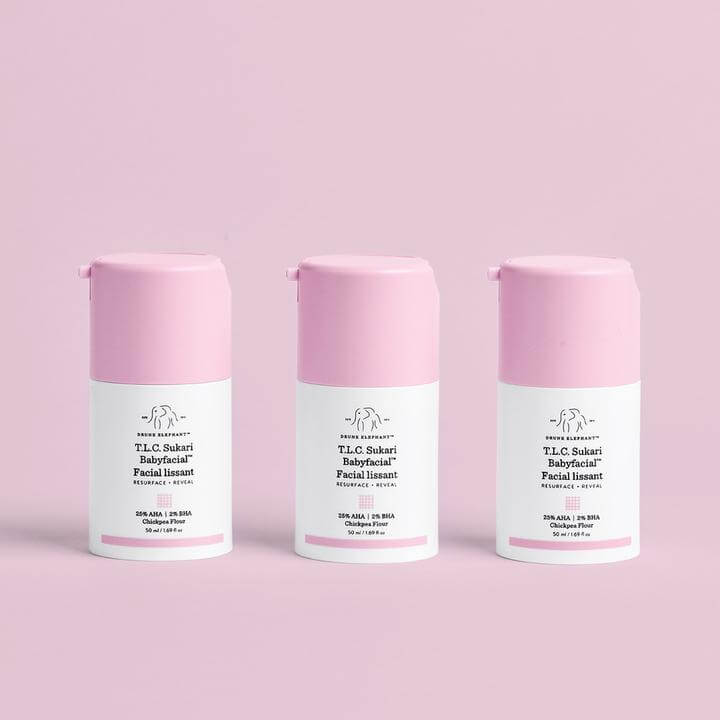
Those with darker skin and evidence of hyperpigmentation need to be extra careful when selecting an at-home chemical peel to purchase. Using the strongest at home chemical peel you can find won’t accelerate your results. On the contrary, you’ll likely end up creating even more hyperpigmentation in the process due to the too-harshness of the chosen product!
This peel by Drunk Elephant is one of our favorites. It is well suited to just about every skin type under the sun, even the most sensitive. The gentle formula is made up of a combination of light acids, and even some chickpea flour to brighten one’s overall complexion.
The pumpkin extract is said to offer antibacterial properties to the skin, as well as antioxidants. The peel has an overall mild pH value, between 3.5 and 3.6.
Best at Home Chemical Peel for Acne Scars
The Ordinary AHA 30% + BHA 2% Peeling Solution
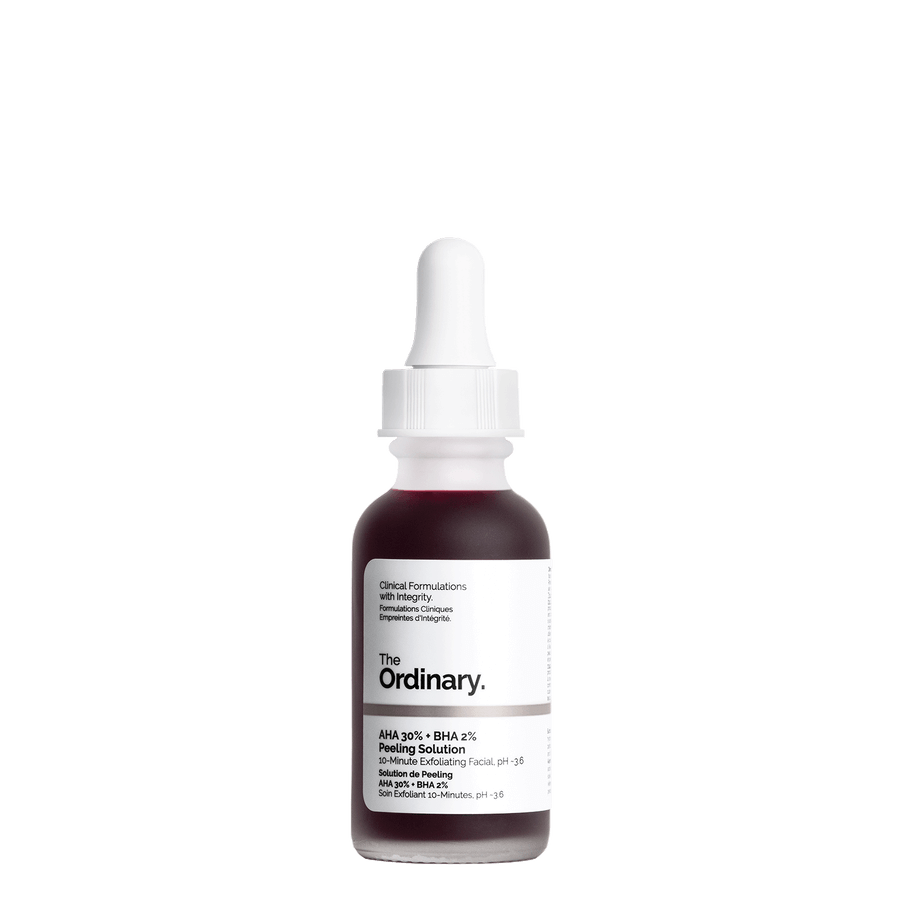
No best product roundup would be complete without a mention of this Sephora chemical peel: The Ordinary’s famous AHA peeling solution.
This blood red formula will glide over your skin like silk, frothing slightly in the process. It offers users a much deeper exfoliation and acidic penetration compared to other drugstore brands, and at a fraction of the price.
The best part about this product (in our opinion) is that you can actually feel it working its magic. A lot of people start to panic when they feel the light tingling sensation take place, but we know it’s simply the product taking much needed action in problem areas.
With this peeling solution you can pretty much expect to see results as early as after just one treatment! Stick with it — you won’t regret this purchase!
Best at Home Chemical Peel for Wrinkles
StackedSkincare TCA Lactic & Glycolic Body Peel
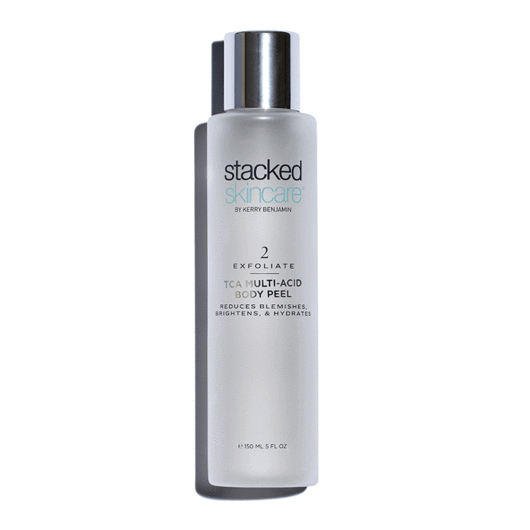
Now this peeling solution may be out of budget for some, but if you’re serious about softening those crows feet, then breaking the bank may be your only option!
Stacked Skincare came to impress when they released their lactic and glycolic body peel. Designed for all over bodily use, this formula is potent and should be used carefully by following the instructions that it comes with. The brand does, however, state that their products are suitable even for skin suffering from eczema!
This five acid complex has the ability to address everything from dark spots to body acne. It can even be used on active breakouts and help to bring them back into balance faster than the body would on its own.
The bonus brush set by Stacked Skincare is not essential, however if you’ll be using this product on places other than your face it can be helpful to have!
Best Home Chemical Peel Kit
Ellen Lange Glycolic Chemical Facial Treatment Kit

Doing deep chemical peels at home doesn’t get much easier than this all inclusive kit. Featuring 8 treatments & 60 glycolic pads, the kit also comes with peel prep, a fan brush, and a medicine cup.
Basically, it’s a three step program to younger, plumper and more vibrant skin. First one starts with the exfoliating peel prep solution that prepares the skin for the peeling acids. Next follows the peeling pads, which aren’t the main event and are gentle enough for daily usage.
The main peel is the glycolic peel solution that you’ll use once a week/fortnightly. The kit tackles facial skin from many different angles; targeting dark spots, uneven pores, wrinkles and also dryness.
Best Chemical Peel for Aging Skin
Renée Rouleau Triple Berry Smoothing Peel
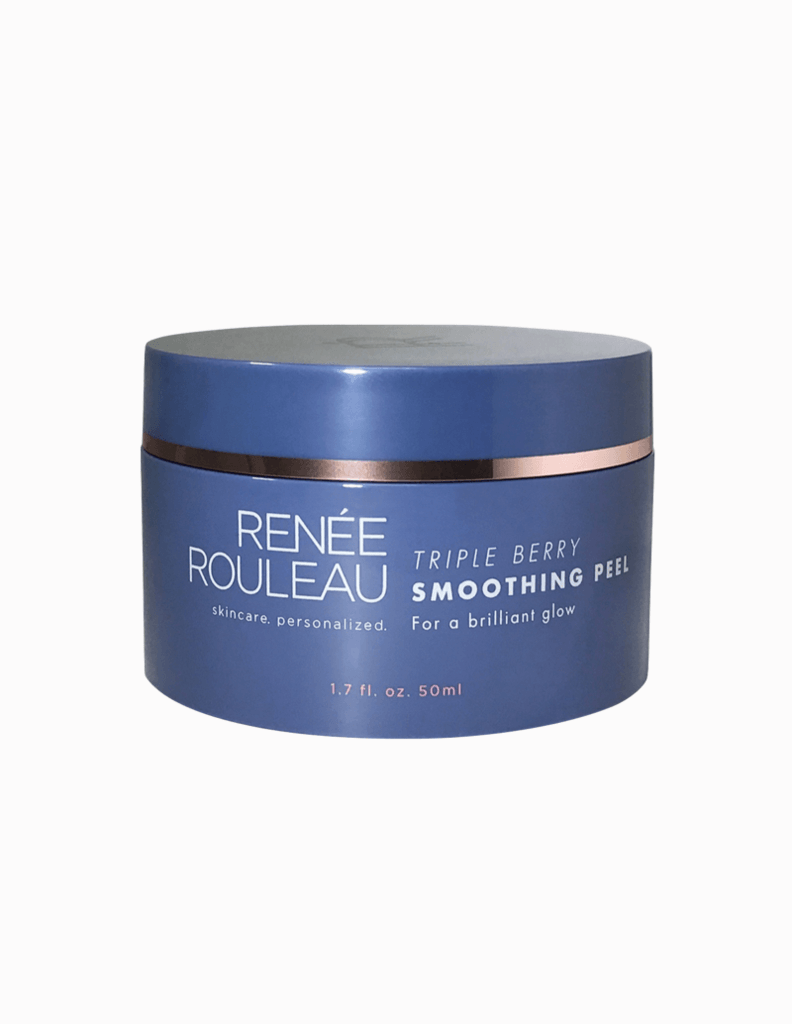
Skin needs optimal radiance in order to balance out the effects of aging. In this way, even heavily aged skin appears more youthful than those of similar time zone!
This particular peel can be used four times a month, and is a tub of fruit-filled deliciousness with some kind of glow magic within! Packed with raspberry seeds, pomegranate and blueberry extract, as well as strawberries, exfoliation and antioxidants are the star of the show.
We love this product on the face, but we also found it works wonders to brighten the skin of the hands, upper arms and even the chest area. A tub of the Triple Berry doesn’t come cheap, but it lasts a long time if you use it to schedule!
Best Professional Chemical Peels
Hanacure All-In-One Facial – Set
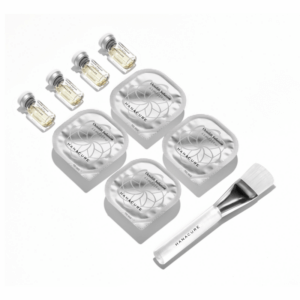
If you want to bring a professional grade chemical peel into your home to DIY, then Hanacure is the only product worth looking at. A word of caution: this is an extremely powerful chemical peel, and should be used with care after doing extensive research!
Hanacure offers users a soothing facial gel that quickly tightens on the skin. When we say tightens, we mean tightens. It gets quite comical when one loses complete ability to make facial expressions while this mask is on!
After 20 minutes, you’ll wash it off to reveal a newly flawless complexion, free of all impurities and visibly refined. The solution is so effective that it won a Harper’s Bazaar Anti-Aging Award in 2019!
One set gives you 4 treatments, including an applicator wand that you’ll need for this kind of acid. The peels have to be mixed by you individually, to activate the compounds. This process is simple and the instructions are clear!
Best Over the Counter Chemical Peel
Obagi Blue Brilliance Triple Acid Peel
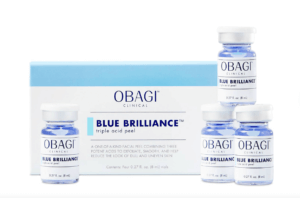
The Blue Brilliance facial peel by Obagi is one of the strongest (and safest) peels that one can get over the counter. Formulated by clinical scientists, this solution is active, proven and potent.
It aims to target fine lines, wrinkles, uneven skin tone, as well as to improve overall skin texture and general glow. Dull skin is a thing of the past when Obagi is involved. The formula is composed of the most powerful forms of salicylic, glycolic, and lactic acids that are permitted for OTC sale.
With a chemical peel this intense, it is crucial that one follow the stipulated instructions. For example, use only one vial every two weeks, never use on wet skin, and don’t panic if you feel mild tingling!
Can you Buy Chemical Peels Over the Counter?
OTC chemical peel brands are abundant in drugstores, e-commerce platforms and even some supermarkets! In this day and age one can absolutely purchase professional-grade chemical peeling solutions over the counter, without much more than an instruction booklet as the only form of red tape.
Using an over the counter chemical peel is at the discretion of the customer, and everyone should do their own in-depth research before committing to a specific product. All skin is different, and with OTC purchases there is often no real life individual one can ask for help. In this instance, the Internet is your best friend! Obsess over the reviews and instructions until you are dead sure a specific product is right for your skin!
Best Drugstore Chemical Peel
Olay Masks Vitamin C + AHA Resurfacing Peel Vitamin C
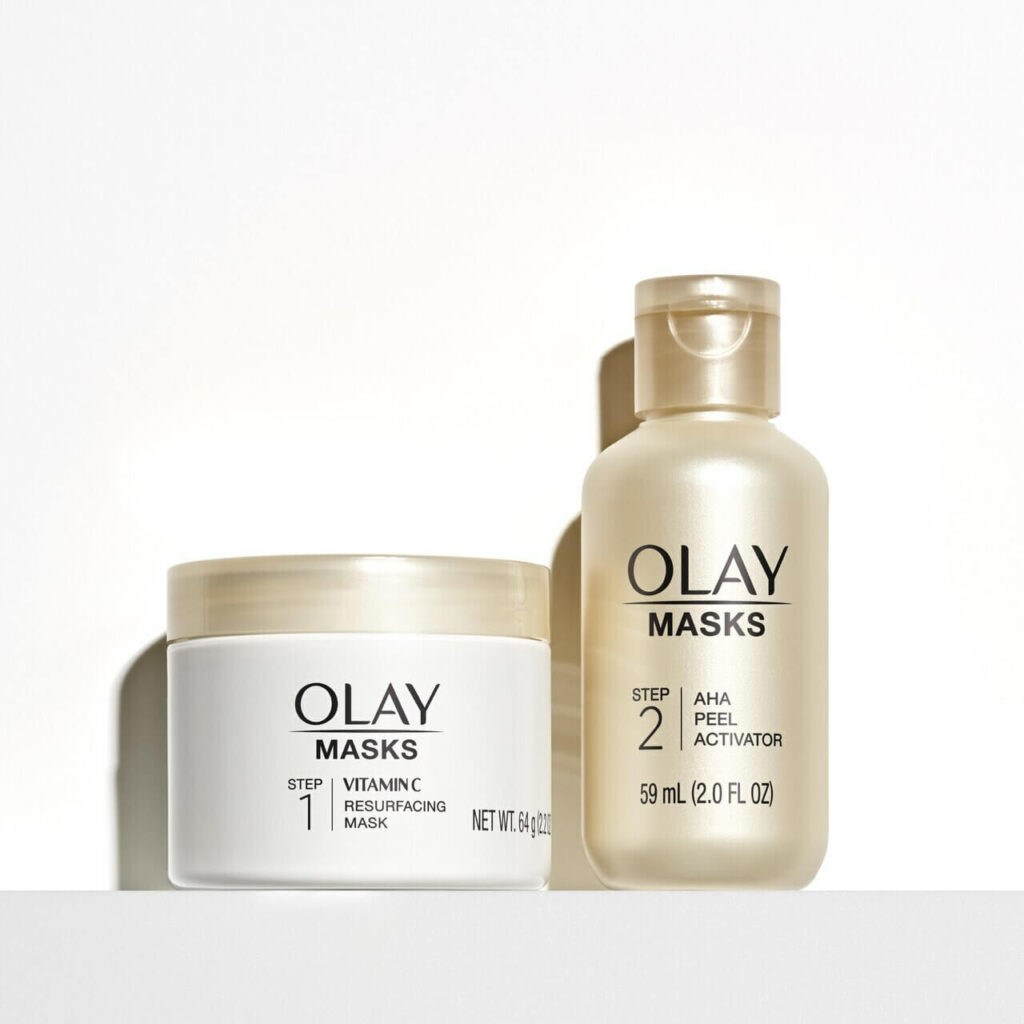
Drugstore brands making chemical peels shouldn’t be overlooked due to their commercial nature. There are many reputable brands making effective peels, suited to just about every skin type!
The Olay AHA and Vitamin C mask is a fantastic two step process that takes dullness from every pore and turns them into something far more lively! The first step in the treatment is the scrub, that exfoliates and prepares the skin to receive the peel (step 2).
The solution is filled with nourishing Vitamin C, that not only helps to slow the aging process, but also protects the skin from environmental contaminants that would further age the face!
The reviews on this product speak for themselves; they have many loyal customers who have used this peel for years, owing the pleasing condition of their skin to Olay and Olay alone!
How to do a Chemical Peel at Home
Can you do a Chemical Peel at Home
First thing’s first, if doing a chemical peel at home feels like it’s going to give you a lot of anxiety or unnecessary stress, consider searching for a “chemical peel dermatologist near me” instead! That said, applying these peels is actually really simple, and for the most part, users have almost nothing to worry about.
The best way to apply a chemical peel at home is to follow the following steps:
- Familiarize yourself with the ingredients of the peel before putting it onto your skin. This way if anything starts going wrong, you can easily narrow it down to a specific component and neutralize it effectively.
- Read the application and/or usage instructions thoroughly. Ensure you have everything you need before you start the peel!
- Find out what to expect from your specific product in terms of sensations. Is mild to moderate tingling normal? What should one do if it starts to burn?
- Prep your face: Chemical peels need to be applied to clean, dry skin. If you’re going to exfoliate first be sure to get all of the product off.
- Apply with care. Some people might like to do a patch test first to see that their skin doesn’t have an immediate adverse reaction to the product.
- Monitor your time. All products will give you a specific waiting period before you’ll need to wash the product off. Don’t go over this time frame thinking that if you leave the peel on longer you’ll get better results; it doesn’t work like this and you can do a lot of damage!
- Wash gently, and pat dry with a soft towel. Do not scrub! Freshly peeled skin is extremely vulnerable and should be treated like you would a newborn baby’s skin!
How to Neutralize a Chemical Peel without Baking Soda
Whether you’re using a store-bought or homemade chemical peel, there is always a risk that your skin might simply not agree with the chemical compounds of the product. It’s unusual, but should one experience this with a home-use product, one needs to take swift action to neutralize the solution.
This is done using baking soda; a household item that is even used in hospitals to neutralize cases where patients have been exposed to acids or poisons. It helps to first understand the pH scale, so you can understand what the baking soda is actually doing to the peel that is now harming your skin.
The pH scale is a unit of measurement that goes from 0 up to 14. In the middle is number 7, which is considered totally neutral or “base level”. The chemical peels that you will use on your skin will fall well below pH 7, making them very acidic to the human body. Baking soda, on the other hand, sits at number 9 on the pH scale, making it incredibly alkaline.
Alkalinity can neutralize acidity, and bring things back to base level, which is why we use baking soda to calm a chemical peel that has gotten slightly out of control!
To neutralize a chemical peel, simply mix 1/4 cup of baking soda with four cups of water, and apply it over the treated skin to slowly wash the peel away. You should feel the tingling/burning subside after a few seconds, and more so the longer the baking soda is left to work!
Chemical Peel At Home: Where to Buy
When shopping for chemical peels to use at home, we’d recommend ordering directly from a brand if possible, and having the product delivered to you. The smaller brands tend to make the most effective products, and you won’t find them in stores near you.
That said, if you would like to purchase a chemical peel in person, poke around your nearest drugstore or department store. Chemists and wellness stores are also great places to look. Alternatively, platforms such as eBay and Amazon have a plethora of products available for worldwide shipping!
Did You Enjoy This Article?
If you enjoyed this article, you might also like our articles discussing skincare such as: Houttuynia Cordata (Heartleaf) and Skincare, Turmeric and Skincare, and Best Natural Anti-Aging Skincare.

